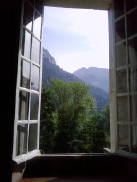Let’s ask again, “What is the nature of the bridge between sense perceptions and concepts? It’s a simple question to ask, but a fairly difficult one to answer.
Raphael Nunez contributed a chapter to the Springer book, Recasting Reality: Wolfgang Pauli’s Philosophical Ideas and Contemporary Science. A pdf of the chapter can be found here. In it he surveys some of Pauli’s ideas as he takes note of the work of both Kepler and Jung. Nunez then looks at how his own work, a cognitive idea analysis of mathematics, relates. Here are a few of the references I most enjoyed. Nunez quotes from a 1952 essay of Pauli’s:
The process of understanding nature as well as the happiness that man feels in understanding, that is, in the conscious realization of new knowledge, seems thus to be based on a correspondence, a `matching’ of inner images pre-existent in the human psyche with external objects and their behavior. This interpretation of scientific knowledge, of course, goes back to Plato,and is, as we shall see, very clearly advocated by Kepler.
And Pauli explains Kepler’s understanding:
He [Kepler] speaks in fact of ideas that are pre-existent in the mind of God and were implanted in the soul, the image of God, at the time of creation. These primary images which the soul can perceive with the aid of an innate`instinct’ are called by Kepler archetypal (`archetypalis’). Their agreement with their ‘primordial images’ or archetypes introduced into modern psychology by C.G. Jung and functioning as `instincts of imagination’ is very extensive.”
Then Jung in a letter to Pauli in 1953, talking about whole numbers, explains that they:
possess that characteristic of the psychoid archetype in classical form – namely, that they are as much inside as outside. Thus, one can never make out whether they have been devised or discovered; as numbers they are inside and as quantity they are outside.”
In the end Nunez outlines, in some detail, how research in cognitive science shows us that sense perceptions and concepts (particulary mathematical ones) are bridged by image schemas, and that human conceptual systems can be decomposed into primitive concepts of spacial relations – like something being “above” something else or “in contact with” something else or “supporting” something else.
What I find most intriguing is that even though the language about it may change, and so may the method of investigating it, the wonderment about things, which are not being constructed from sensory data, persists. Inevitably we are led to consider that there is some aspect to reality that transcends the physical and the temporal. Many modern thinkers have rejected the notion that there is anything more than the physical. But I think that’s missing the point. And the so-called Platonic view of mathematics keeps the question alive. Mathematics is still permitted some mystery. I think it points, as Jung observes, both inside and out and, as Plato once thought, has the unique ability to bridge the real world and the world of images.
In what way is the whole of reality expressed in us? What are we doing when we find representations of things which are not immediately before us or perceived by the senses? How are we related to all there is?
Cognitive science does provide a new window, another view of things, when it looks at what the body does, at the integration of the processes of attention, perception and memory, or the neural dynamics of these processes as well as physiological processes outside of our awareness. It looks to me like ordering is the key, that by ordering the senses build the world. But language and symbol also order. And what they build is there, in much the same way as a tree is there. Everything we live in, physically and culturally, is there. Merry Christmas!


[…] I looked back at a post that I wrote in 2010 with the title, Archetypes, Image Schemas, Numbers and the Season. The subject of the post is a chapter from the book, Recasting Reality: Wolfgang Pauli’s […]